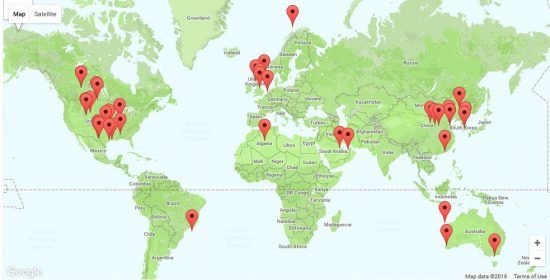

Carbon capture is the one back-end technology we have to make it possible to use fossil fuels to produce energy far into the future. You would think, therefore, that the energy industry, and in particular, fossil fuel producers would be gung-ho to spend hundreds of millions if not billions to make the technology viable. But that has not been the case. Without governments throwing substantial money at carbon capture projects there would be none operating on the planet today.
I have mentioned the Boundary Dam Project in Saskatchewan and Shell’s Quest site in northern Alberta. These are complex multi-billion dollar solutions. A third experimental technology is doing small-scale harvesting of carbon dioxide from the air in British Columbia. In total today there are fewer than 20 active industrial carbon capture facilities in operation globally (see map below). This, however, may soon change.
Professor James Davis of University of South Alabama is working with ionic liquids to separate carbon dioxide from smokestack output in coal and natural-gas fired power plants. The ionic liquid uses nitrogen. The flue gases are bubbled through the nitrogen liquid which takes out the carbon dioxide (CO2). The removed CO2 can then be pumped underground while the ionic liquid can be recycled to capture more of the gas. If this laboratory solution can be scaled to a range of applications, from capturing CO2 in non-industrial and industrial buildings, and even be incorporated for use in vehicles then the fossil fuel industry may have found a solution desperately needed to help mitigate carbon’s impact on global warming.
Davis’ research into ionic liquids is looking at their practical use as solvents, electrolytes, high-tech lubricants, propellants and medicines. He first became interested in the properties of these naturally occurring liquids while studying how some ant populations can use the formic acid they produce as a means to tolerate formic-acid based venom from other ant colonies. In identifying the molecular components of the formic acid, Davis was able to identify the role ionic liquids played in inoculating the ants. Now he is using natural-occurring ionic liquids and applying them to industrial processes. His research is partially funded by grants from the National Science Foundation, Chevron and the Petroleum Research Fund.
If I were Exxon-Mobil I’d be putting some big bucks behind Davis and other carbon capture technologies. That and large investments in clean renewable energy may be the only future for these companies if global leadership is serious about tackling anthropogenic climate change.




